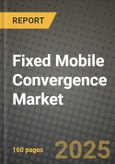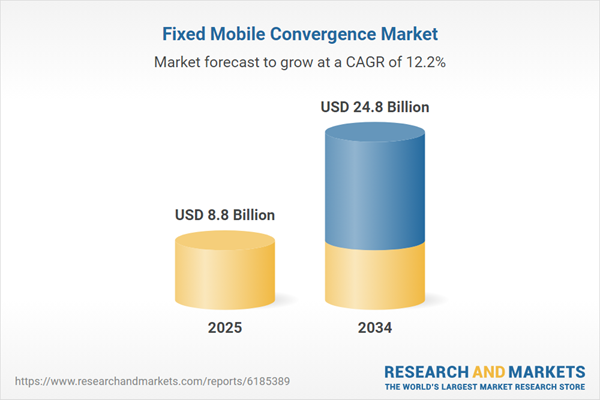Fixed Mobile Convergence Market Overview
Fixed Mobile Convergence (FMC) is transforming the telecommunications landscape by seamlessly integrating fixed-line and mobile communication services into a unified platform. This convergence enables users to switch effortlessly between fixed and mobile networks without disruptions, enhancing connectivity, convenience, and cost efficiency. As enterprises and consumers demand seamless communication experiences, telecom operators are leveraging FMC to deliver unified communication solutions, improving operational efficiency and customer satisfaction. The increasing adoption of 5G networks, cloud-based communication, and Voice over Wi-Fi (VoWiFi) is accelerating the FMC market, allowing businesses and individuals to stay connected across multiple devices and locations. Enterprises are increasingly deploying FMC solutions to streamline operations, enable remote working, and enhance workforce mobility. Moreover, the rapid digital transformation across industries, along with the growing trend of hybrid work models, is propelling market growth. Telecom providers are focusing on developing next-generation network architectures that combine broadband, cellular, and IP-based communication, ensuring seamless service continuity.The Fixed Mobile Convergence market is witnessing substantial growth driven by advancements in 5G technology and cloud-based network solutions. Telecom operators are launching integrated 5G FMC services, allowing users to experience uninterrupted connectivity between mobile and fixed-line networks. The demand for seamless communication solutions is rising as businesses continue to adopt hybrid work environments, necessitating reliable and flexible connectivity. Several telecom providers have introduced FMC solutions that offer single-number reachability, integrated voice and data services, and enhanced security features. Additionally, enterprises are deploying private 5G networks combined with fixed broadband solutions to support mission-critical applications, remote workforce connectivity, and smart infrastructure. The proliferation of IoT devices and smart home ecosystems is further fueling the adoption of FMC, as consumers seek unified connectivity solutions for home and office environments. Moreover, regulatory bodies are actively supporting the deployment of FMC infrastructure by facilitating spectrum allocation and easing network convergence policies. The increased emphasis on cybersecurity and data privacy in converged networks has also become a key focus area for market players.
The Fixed Mobile Convergence market is expected to experience accelerated growth driven by AI-powered network optimization, network slicing, and edge computing advancements. The continued expansion of 5G networks will further enhance FMC capabilities, enabling ultra-low latency, high-speed data transfer, and superior service quality. Telecom operators will increasingly integrate AI-driven analytics and automation to manage network traffic, predict outages, and optimize bandwidth allocation in real time. Furthermore, the emergence of 6G research and development will shape the future of FMC by enabling even more seamless connectivity experiences. The growing adoption of cloud-native and software-defined networking (SDN) architectures will empower businesses to implement flexible, scalable, and cost-effective communication solutions. Smart city initiatives and Industry 4.0 developments will drive demand for FMC-enabled infrastructure, supporting applications such as autonomous vehicles, remote healthcare, and industrial automation. Additionally, the rise of subscription-based and consumption-driven telecom models will reshape pricing strategies, making FMC solutions more accessible to enterprises and consumers alike. As the demand for unified communication ecosystems continues to rise, telecom providers will focus on expanding their service portfolios, enhancing security protocols, and improving interoperability between fixed and mobile networks.
Key Insights: Fixed Mobile Convergence Market
- Integration of 5G and Wi-Fi 6 for Enhanced Connectivity: The combination of 5G and Wi-Fi 6 is enabling faster, more reliable, and low-latency connectivity, driving the adoption of FMC across enterprise and consumer applications.
- AI-Powered Network Optimization: Telecom providers are leveraging AI and machine learning to optimize network performance, predict network failures, and enhance user experiences in FMC environments.
- Rise of Private 5G Networks in Enterprises: Organizations are deploying private 5G networks in combination with fixed broadband to ensure seamless connectivity for industrial automation, remote work, and IoT applications.
- Growth of Cloud-Based Unified Communications: The increasing adoption of cloud-based communication platforms is facilitating seamless fixed and mobile network integration, enabling remote collaboration and business continuity.
- Expansion of Smart Home and IoT Ecosystems: The proliferation of smart home devices and IoT applications is driving demand for FMC solutions that offer unified connectivity, allowing users to manage all their devices seamlessly.
- Increasing Demand for Seamless Connectivity: Businesses and consumers require uninterrupted, high-speed, and reliable connectivity solutions, fueling the adoption of FMC to bridge fixed and mobile networks.
- Rapid Deployment of 5G Networks: The expansion of 5G infrastructure worldwide is enhancing FMC capabilities, enabling faster data transfer, improved mobility, and better service continuity.
- Growth of Remote Work and Hybrid Work Models: As remote and hybrid work arrangements become the norm, enterprises are investing in FMC solutions to support flexible communication and workforce mobility.
- Regulatory Support and Spectrum Allocation: Governments and regulatory bodies are facilitating the deployment of FMC infrastructure by easing network integration policies and enabling efficient spectrum management.
- Security and Privacy Concerns in Converged Networks: As fixed and mobile networks merge, the risk of cyber threats, data breaches, and unauthorized access increases, requiring telecom providers to implement robust security frameworks and advanced encryption protocols.
Fixed Mobile Convergence Market Segmentation
By Convergence Type
- Session Redirection
- Private Branch Exchange (PBX) Mobility
- Client Software
- Dual Mode Support
By Component
- Voice
- Videotelephony
- Social Networking
- Broadband Internet
- Broadband Television (TV)
By Service Provider
- Mobile
- Broadband
- Combined
By End-User
- Home Users
- Enterprises
- Information Technology (IT) and Telecommunications (Telecom)
- Banking
- Financial Services
- and Insurance (BFSI)
- Automotive
- Healthcare
- Media and Entertainment
- Government
Key Companies Analysed
- Samsung Electronics Co. Ltd.
- Verizon Communications Inc.
- AT&T Inc.
- Huawei Technologies Co. Ltd.
- T-Mobile US Inc.
- Cisco Systems Inc.
- Orange S.A.
- Telefonica S.A.
- Fujitsu Limited
- Ericsson
- Deutsche Telekom AG
- Nokia Corporation
- NEC Corporation
- ZTE Corporation
- Motorola Solutions Inc.
- BT Group plc
- Juniper Networks Inc.
- Amdocs Limited
- Avaya LLC
- Mitel Networks Corporation
- Mavenir
- Radisys Corporation
- Ribbon Communications Operating Company Inc.
- CounterPath Corporation
- Tango Networks Inc.
Fixed Mobile Convergence Market Analytics
The report employs rigorous tools, including Porter’s Five Forces, value chain mapping, and scenario-based modeling, to assess supply-demand dynamics. Cross-sector influences from parent, derived, and substitute markets are evaluated to identify risks and opportunities. Trade and pricing analytics provide an up-to-date view of international flows, including leading exporters, importers, and regional price trends.
Macroeconomic indicators, policy frameworks such as carbon pricing and energy security strategies, and evolving consumer behavior are considered in forecasting scenarios. Recent deal flows, partnerships, and technology innovations are incorporated to assess their impact on future market performance.Fixed Mobile Convergence Market Competitive Intelligence
The competitive landscape is mapped through proprietary frameworks, profiling leading companies with details on business models, product portfolios, financial performance, and strategic initiatives. Key developments such as mergers & acquisitions, technology collaborations, investment inflows, and regional expansions are analyzed for their competitive impact. The report also identifies emerging players and innovative startups contributing to market disruption.
Regional insights highlight the most promising investment destinations, regulatory landscapes, and evolving partnerships across energy and industrial corridors.Countries Covered
- North America - Fixed Mobile Convergence market data and outlook to 2034
- United States
- Canada
- Mexico
- Europe - Fixed Mobile Convergence market data and outlook to 2034
- Germany
- United Kingdom
- France
- Italy
- Spain
- BeNeLux
- Russia
- Sweden
- Asia-Pacific - Fixed Mobile Convergence market data and outlook to 2034
- China
- Japan
- India
- South Korea
- Australia
- Indonesia
- Malaysia
- Vietnam
- Middle East and Africa - Fixed Mobile Convergence market data and outlook to 2034
- Saudi Arabia
- South Africa
- Iran
- UAE
- Egypt
- South and Central America - Fixed Mobile Convergence market data and outlook to 2034
- Brazil
- Argentina
- Chile
- Peru
Research Methodology
This study combines primary inputs from industry experts across the Fixed Mobile Convergence value chain with secondary data from associations, government publications, trade databases, and company disclosures. Proprietary modeling techniques, including data triangulation, statistical correlation, and scenario planning, are applied to deliver reliable market sizing and forecasting.Key Questions Addressed
- What is the current and forecast market size of the Fixed Mobile Convergence industry at global, regional, and country levels?
- Which types, applications, and technologies present the highest growth potential?
- How are supply chains adapting to geopolitical and economic shocks?
- What role do policy frameworks, trade flows, and sustainability targets play in shaping demand?
- Who are the leading players, and how are their strategies evolving in the face of global uncertainty?
- Which regional “hotspots” and customer segments will outpace the market, and what go-to-market and partnership models best support entry and expansion?
- Where are the most investable opportunities - across technology roadmaps, sustainability-linked innovation, and M&A - and what is the best segment to invest over the next 3-5 years?
Your Key Takeaways from the Fixed Mobile Convergence Market Report
- Global Fixed Mobile Convergence market size and growth projections (CAGR), 2024-2034
- Impact of Russia-Ukraine, Israel-Palestine, and Hamas conflicts on Fixed Mobile Convergence trade, costs, and supply chains
- Fixed Mobile Convergence market size, share, and outlook across 5 regions and 27 countries, 2023-2034
- Fixed Mobile Convergence market size, CAGR, and market share of key products, applications, and end-user verticals, 2023-2034
- Short- and long-term Fixed Mobile Convergence market trends, drivers, restraints, and opportunities
- Porter’s Five Forces analysis, technological developments, and Fixed Mobile Convergence supply chain analysis
- Fixed Mobile Convergence trade analysis, Fixed Mobile Convergence market price analysis, and Fixed Mobile Convergence supply/demand dynamics
- Profiles of 5 leading companies - overview, key strategies, financials, and products
- Latest Fixed Mobile Convergence market news and developments
Additional Support
With the purchase of this report, you will receive:- An updated PDF report and an MS Excel data workbook containing all market tables and figures for easy analysis.
- 7-day post-sale analyst support for clarifications and in-scope supplementary data, ensuring the deliverable aligns precisely with your requirements.
- Complimentary report update to incorporate the latest available data and the impact of recent market developments.
This product will be delivered within 1-3 business days.
Table of Contents
Companies Mentioned
- Samsung Electronics Co. Ltd.
- Verizon Communications Inc.
- AT&T Inc.
- Huawei Technologies Co. Ltd.
- T-Mobile US Inc.
- Cisco Systems Inc.
- Orange S.A.
- Telefonica S.A.
- Fujitsu Limited
- Ericsson
- Deutsche Telekom AG
- Nokia Corporation
- NEC Corporation
- ZTE Corporation
- Motorola Solutions Inc.
- BT Group PLC
- Juniper Networks Inc.
- Amdocs Limited
- Avaya LLC
- Mitel Networks Corporation
- Mavenir
- Radisys Corporation
- Ribbon Communications Operating Company Inc.
- CounterPath Corporation
- Tango Networks Inc.
Table Information
| Report Attribute | Details |
|---|---|
| No. of Pages | 160 |
| Published | October 2025 |
| Forecast Period | 2025 - 2034 |
| Estimated Market Value ( USD | $ 8.8 Billion |
| Forecasted Market Value ( USD | $ 24.8 Billion |
| Compound Annual Growth Rate | 12.2% |
| Regions Covered | Global |
| No. of Companies Mentioned | 25 |









